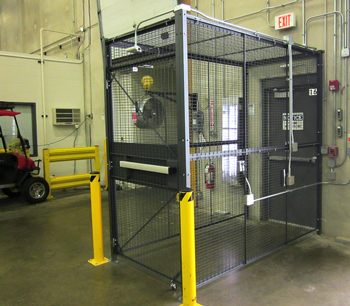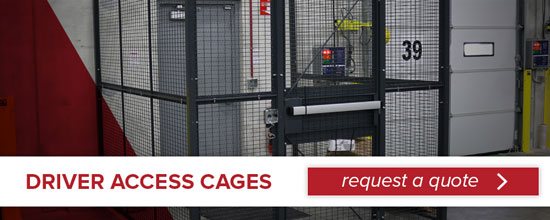Three Key Ways Driver Cages Make the Warehouse Safer
In any warehouse or distributing environment, it’s critical to prevent injuries and accidents, protect equipment, and make sure valuable inventory is secure. When it comes to the shipping and receiving area, security too often goes overlooked. Most busy operations don’t have the time to monitor visitors, delivery drivers, service providers, and others who enter the warehouse—much less total strangers who can enter through open doors in a bustling shipping or receiving operation.
Neglecting to limit access to the facility invites visitors of all types to wander around warehouse aisles, where they have access to inventory, tools, and private areas. This also makes your employees less safe. Even if the visitor is a legitimate guest, you should control his or her access to your facility.
What are some specific steps companies can take to make the warehouse safer?
When placed in shipping and receiving areas, driver cages can serve as secure waiting stations for drivers and other facility visitors until they can be properly admitted. Here’s a look at 3 key benefits of driver cages:
1. Monitor and Control Guest Access
 Driver security cages (also called man traps, dock cages, and partitions) are an excellent way to allow visitors access to the building without allowing them access to a warehouse’s entire inventory. In other words, visitors can enter the facility through the door, but can’t get out of the cage itself, allowing warehouses to decide who to admit and when (and prevent potential theft and pilferage).
Driver security cages (also called man traps, dock cages, and partitions) are an excellent way to allow visitors access to the building without allowing them access to a warehouse’s entire inventory. In other words, visitors can enter the facility through the door, but can’t get out of the cage itself, allowing warehouses to decide who to admit and when (and prevent potential theft and pilferage).
For additional security and to make monitoring and controlling guest access easier, facilities can customize driver cages with service windows, steel benches, push bars, ceiling panels, and more. Driver cages, available in 2- and 3-sided configurations, can also be configured to suit a facility’s specific application.
2. Protect Visitors From Dangerous, Moving Machinery
Another distinct benefit of driver security cages is that they’re helpful for safety considerations. When placed in high-traffic shipping and receiving areas, driver cages help keep accidents at bay and prevent visitors from entering freely into forklift aisles or coming in contact with other dangerous, moving machinery.
Because driver access cages are usually located in active shipping dock areas, WireCrafters’ GuardRail Safety Railing System can be installed around the perimeter of the access cage for added protection.
3. Double As Employee Entrance and Emergency Exit
In addition to serving as a “man trap” for truck drivers, delivery personnel, salespeople, and other visitors, driver cages can also double as an employee entrance to the facility. More importantly, when installed in combination with a full width push bar, driver cages can be used as a quick exit in an emergency situation.
Sage Products, for example, had WireCrafters add an electromagnetic lock to their driver access cage so that employees could enter through the exterior door, swipe their employee badge on the inside of the driver cage, and enter into the secured warehouse area. In case of an emergency that would require employees to leave the warehouse area quickly, Sage Products had WireCrafters add a full width push bar to their driver cage.
Final Thoughts
In shipping and receiving areas, where crew is preoccupied with work and might not have time to monitor visitors, driver cages can help prevent accidents while protecting equipment, inventory, and employees. Driver cages keep truck drivers and delivery personnel secluded in one place when entering the warehouse or making a delivery, which can also prevent unauthorized personnel from wandering the facility and potentially leaving with something.
How have you secured your shipping and receiving area?
This article was contributed by Scott Stone of Cisco-Eagle, Inc., a provider of integrated material handling and storage systems for industrial operations. Scott has over 23 years of experience in industrial operations.
To learn more about our Driver Cages or get a quote, please click the image below.
